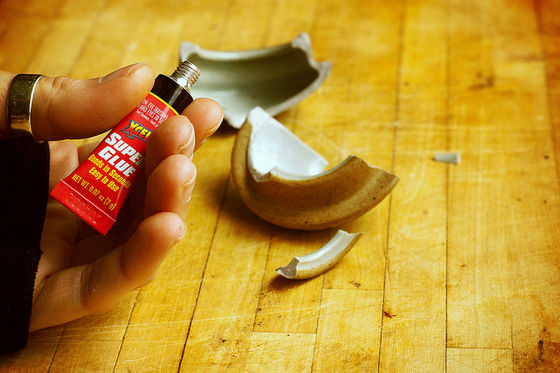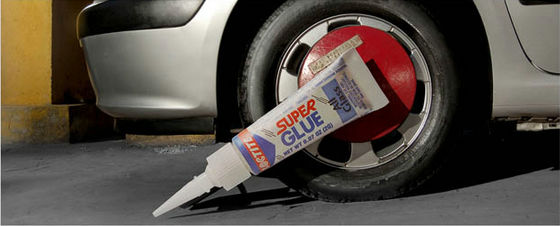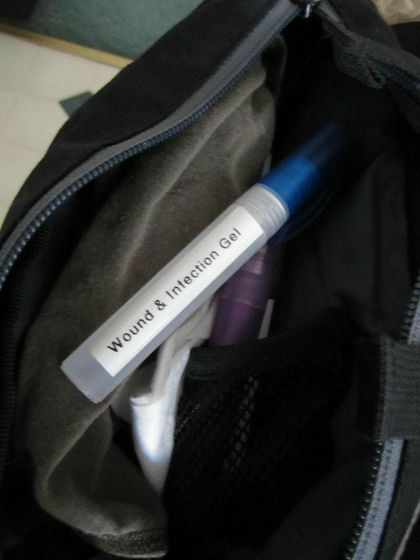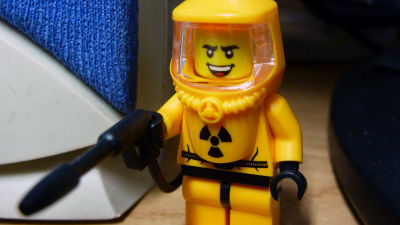Strong instantaneous adhesive talks beyond the "adhesive" area that has served to assemble nuclear weapons and treat soldiers

ByDaniel
"Pocket watch" and "watch" were born from warAs such, military and government-led research may create technologies that will bring innovation to the world. One of them is a powerful instantaneous adhesive which Prasmaller uses to assemble a model, or when fixing a thing by first aid during DIY. The main ingredient of a strong instantaneous adhesive "Cyanoacrylate"Has shown his success in various fields that does not fit within the framework of" adhesive ".
Super Glue Built Planes, Nukes and Saved Soldiers' Lives | War Is Boring
http://warisboring.com/articles/super-glue-built-planes-nukes-and-saved-soldiers-lives/
Cyanoacrylate has been used not only as an organic compound used in experiments of plastics but also as a main component of industrial adhesives and even first aid of soldiers hurt on the battlefield. It was before the Second World War that such a cyanoacrylate was born.

ByDavid Goehring
Harry Wesley Cover, the creator of a powerful instantaneous adhesive, is the man who worked at Eastman Kodak in New York in the USA. Although Kodak is a company known as a photographic film manufacturing company, after the first World War I rushed, it was said that the camera was supplied to the communication troops of the US military and training was done on usage. In addition, Kodak also supplied cellulose acetate for cellulose acetate for cell dressing (paint for strengthening, protecting, smoothing of the cloth part of the fuselage) and celluloid for gas mask in the US Navy.
And in 1941, during the Second World War, Kodak gathered their optical engineers and work on the development of precise bomb sighting and night vision scope. While developing these military-related technologies, Kodak scientists seem to have created new plastics and chemicals, one of them was "cyanoacrylate".
In 1942, Mr. Cover's research team succeeded in producing optimum transparent plastic for gun aiming. In the experiment, we have produced several different compounds, and it seems that we succeeded in making cyanoacrylate monomer by compressing formaldehyde and cyanoacetic acid among them. In the presence of moisture, this monomer bonds quickly to each other, forming a long polymer chain, resulting in a cured transparent plastic, which was considered a suitable material for gun targeting.
"But we will encounter another problem, cyanoacrylate monomers will adhere everything," Mr. Cover talks about when cyanoacrylate was first created. However, at this point, Mr. Cover did not understand firmly the characteristics of adhering any substances of cyanoacrylate, it seems to have judged only that it is "too sticky to use as gun aiming point" .

ByArturo de Albornoz
From the 1930s to the 1940s, aircraft canopies were changed from glass to acrylic. Acrylic which is easy to form and tough is able to provide the pilot with a clearer field of view than glass, which seems to have been useful. After that, strong, robust, heat resistant materials that can withstand the canopy in the cockpit part of the jet flying at higher speed than the propeller propulsion machine will be required.
Kodak will start researching with Mr. Cover to find transparent plastics that can withstand jet canopies. Mr. Fred Joyner, one of Mr. Cover's colleagues, was working on the refractive index of the light of each compound from the list of composites. In this experiment, Mr. Joiner seemed to investigate the refractive index by sandwiching ethyl · cyanoacrylate between two refractometers (glass) which cost as much as 700 dollars. I tried to write down the number and try to remove the refractometer, but cyanoacrylate has adhered two expensive glasses, for the first time here Mr. Cover said "Cyanoacrylate has excellent properties as an adhesive I notice. Indeed, Mr. Cover looked back at the time and said, "When I first discovered cyanoacrylate, I did not know at all. Cyanoacrylate was not a new material for casting that we were looking for, but a unique new adhesive It is said.
After that, Mr. Cover attached everything that was in the laboratory with cyanoacrylate and knows that the cyanoacrylate is more powerful and instantly dry than any adhesive that could be used at the time. Also, unlike epoxy resin and other adhesives, cyanoacrylate was a substance that can be solidified without depending on a specific catalyst, so it was said that the characteristic of being relatively easy to handle was also a major point.
Mason & Hanger, a soil construction company, first sold a powerful instantaneous adhesive based on such cyanoacrylate as its main ingredient. From 1956 to 2001, Mason & Hanger is also a company that has been responsible for American nuclear weapon assembly. According to Mr. Cover, Mason & Hanger seems to have used powerful instantaneous adhesives to assemble nuclear weapons.

ByAndrew Plumb
If you've ever used a powerful instantaneous adhesive, I think you have experienced your fingers sticking with glue. Mr. Coover seems to have felt that cyanoacrylate may be able to make a big revolution in medical injury treatment when witnessing industrial customers suffering from this problem. As perceived by that intuition, Mr. Cover realized the dream in the medical field of "medical treatment without seams" with a strong instantaneous adhesive. In 1960, Eastman Kodak in Tennessee cooperated with Ethicon, a subsidiary of Johnson & Johnson, repeated animal experiments and human experiments and investigated the impact of using chemicals on the battlefield.
With the advent of cyanoacrylate, the military doctor can join and block veins, arteries, intestines, etc. without suturing. In addition, the ophthalmologist seems to be able to easily carry out a very difficult procedure by the conventional method by applying cyanoacrylate to the soldier who cut the eyeball.
However, when using cyanoacrylate in the medical field, usage differs from when assembling parts of nuclear weapons. In Eastman's research, cyanoacrylate in adhesives has been found to be toxic to the body of animals, and it has also been shown to increase inflammation and formaldehyde concentration in the human body. Therefore, when using it for medical purposes, a method is devised that uses only specific cyanoacrylate which showed little toxicity in clinical trials. It should be noted that "a specific cyanoacrylate that showed little toxicity" has a long polymer chain and solidifies more instantly than a cyanoacrylate used for industrial strong instantaneous adhesives, It seems to be used as a hemostatic agent rather than.

ByRhona-Mae Arca
The US Army Medical Biomechanics Laboratory will show strong interest in the hemostatic agent using cyanoacrylate invented by Eastman. This seems to be due to the Vietnam War in which American soldiers were dispatched in the 1960s, as many of the US soldiers fell because of bleeding in the chest and abdomen. The institute will provide a significant research cost to cyanoacrylate and develop disposable spray type hemostats. While other competing products were unsuitable for use on the battlefield, those made by the military were able to withstand use on the battlefield, so that they were provided to medical teams dispatched to the Vietnam War in 1966 It seems that it came to be done. This spray is to help the soldier just before the bleeding death on the battlefield, although it is not widely used in the military, it seems that it gave a lot of results at the time of use.
According to a study by Shantell Champagne of the University of Alberta, although it is believed that the hemostatic spray with cyanoacrylate was successful in stopping all of the hemostasis, only four cases out of 30 were left in the sentences . Such a hemostatic spray made of cyanoacrylate has a past that it was not able to obtain the certification easily because there is a safety problem from FDA.
Although Eastman issued a cyanoacrylate hemostatic spray new drug application form for application in 1964, the FDA says, "When cyanoacrylate is used in a large number of transplant surgeries for rats, harmful tumors Can not approve "as a new drug. However, Mr. Cover criticizes as "if anything causes the tumor" if it is FDA's test method. In addition, if only using a cyanoacrylate hemostatic spray locally, it will become evident in other tests that the number in the body will return to normal in about 14 days. In Japan in 1963, Germany in 1968 was approved for the use of cyanoacrylate hemostatic agent, but FDA seems to have not approved it until 1998 even if international research results came out.
Related Posts:
in Note, Posted by logu_ii







